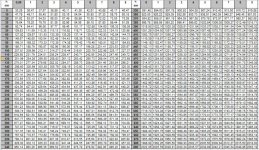Attached Images

I think that your formula is too complicated.
It can be simplified if you divide your horizontal cylinder into two separate problems: (1)Level = 1/2 tank radius or less, and (2)Level Greater than 1 radius. These two levels can be easily computed separately at the proper times by using comparison limits.
(1)Level = 1 radius or less (half full or less):
Volume = Area x Length, where Area = R^2[cos^-1(R-h/R)], cos^-1= Inverse Cosine, R = constant Tank Radius, h = measured height of liquid.
(2)Level = Greater than 1 radius (more than half full):
Volume = Area x Length, where Area = R^2[PI-cos^-1(h-R/R)].
Using this formula, you will see that the max error (as liquid is added or removed from tank, waves are produced) will occur at liquid height = tank radius +/- 10%. You could apply your filter at that level only.
A programmed filter routine simply averages reading over some time period, or averages a New Reading with some sum of Old Readings. This will help to reduce errors caused by actual liquid level fluctuations (waves in tank), errors in level sensor, and electrical noise.
I think that your formula is too complicated.
It can be simplified if you divide your horizontal cylinder into two separate problems: (1)Level = 1/2 tank radius or less, and (2)Level Greater than 1 radius. These two levels can be easily computed separately at the proper times by using comparison limits.
(1)Level = 1 radius or less (half full or less):
Volume = Area x Length, where Area = R^2[cos^-1(R-h/R)], cos^-1= Inverse Cosine, R = constant Tank Radius, h = measured height of liquid.
(2)Level = Greater than 1 radius (more than half full):
Volume = Area x Length, where Area = R^2[PI-cos^-1(h-R/R)].
Using this formula, you will see that the max error (as liquid is added or removed from tank, waves are produced) will occur at liquid height = tank radius +/- 10%. You could apply your filter at that level only.
A programmed filter routine simply averages reading over some time period, or averages a New Reading with some sum of Old Readings. This will help to reduce errors caused by actual liquid level fluctuations (waves in tank), errors in level sensor, and electrical noise.
Last edited:








